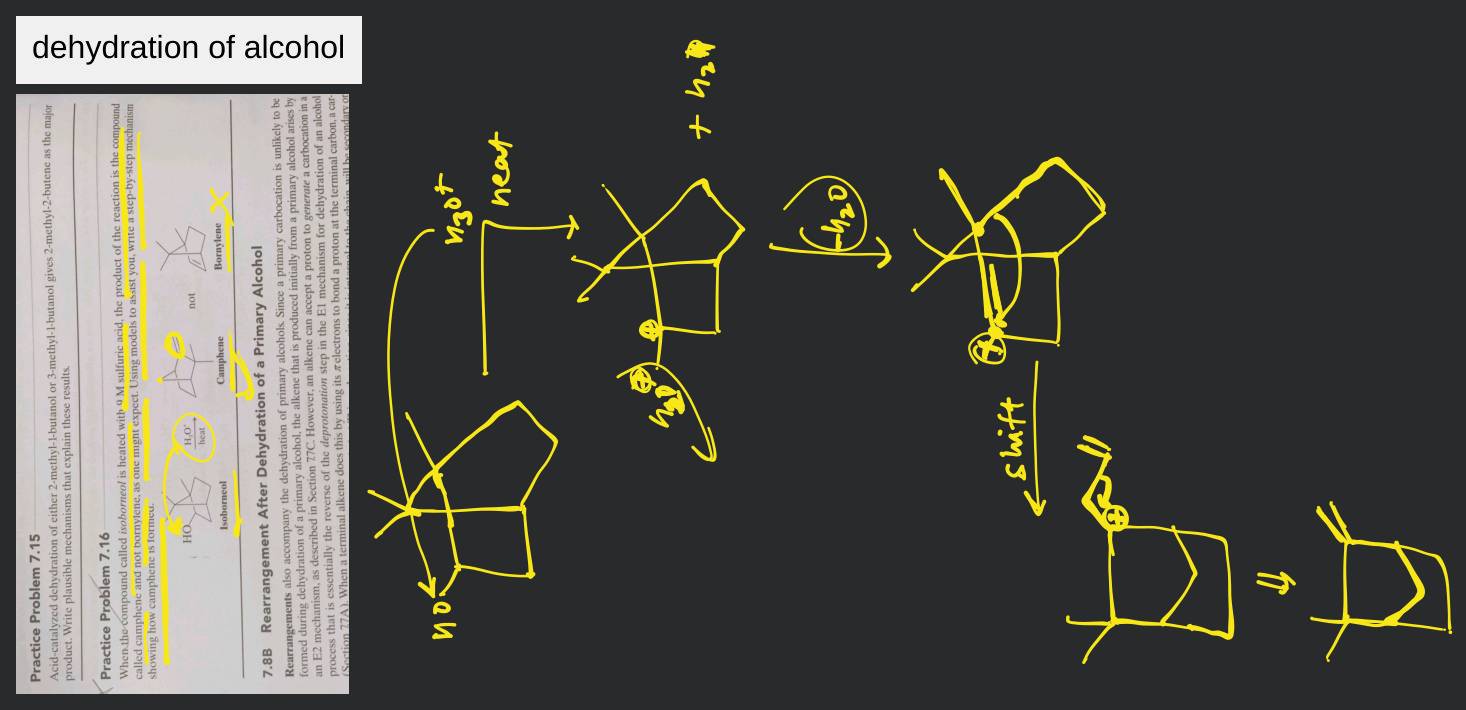Question
Question asked by Filo student
Practice Problem 7.15 Acid-catalyzed dehydration of either 2-methyl-1-butanol or 3-methyl-1-butanol gives 2-methyl-2-butene as the major product. Write plausible mechanisms that explain these results. Practice Problem 7.16 When the compound called isoborneol is heated with sulfuric acid, the product of the reaction is the compound called camphene and not bornylene, as one might expect. Using models to assist you, write a step-by-step mechanism showing how camphene is formed. Isoborneol Camphene Bornylene 7.8B Rearrangement After Dehydration of a Primary Alcohol Rearrangements also accompany the dehydration of primary alcohols. Since a primary carbocation is unlikely to be formed during dehydration of a primary alcohol, the alkene that is produced initially from a primary alcohol arises by an E2 mechanism, as described in Section 7.7C. However, an alkene can accept a proton to generate a carbocation in a process that is essentially the reverse of the deprotonation step in the E1 mechanism for dehydration of an alcohol (Section 77A). When a terminal alkene does this by using its electrons to bond a proton at the terminal carbon, a car-

Found 4 tutors discussing this question
Discuss this question LIVE
14 mins ago

One destination to cover all your homework and assignment needs
Learn Practice Revision Succeed

Instant 1:1 help, 24x7
60, 000+ Expert tutors

Textbook solutions
Big idea maths, McGraw-Hill Education etc

Essay review
Get expert feedback on your essay

Schedule classes
High dosage tutoring from Dedicated 3 experts
Practice more questions on Alcohols, Phenols & Ethers
Question 1
Easy
Views: 5,964
Question 2
Medium
Views: 5,791
Students who ask this question also asked
Question 1
Views: 5,471
Question 3
Views: 5,299
Question 4
Views: 5,316


Stuck on the question or explanation?
Connect with our Chemistry tutors online and get step by step solution of this question.
231 students are taking LIVE classes
| Question Text | Practice Problem 7.15
Acid-catalyzed dehydration of either 2-methyl-1-butanol or 3-methyl-1-butanol gives 2-methyl-2-butene as the major product. Write plausible mechanisms that explain these results.
Practice Problem 7.16
When the compound called isoborneol is heated with sulfuric acid, the product of the reaction is the compound called camphene and not bornylene, as one might expect. Using models to assist you, write a step-by-step mechanism showing how camphene is formed.
Isoborneol
Camphene
Bornylene
7.8B Rearrangement After Dehydration of a Primary Alcohol
Rearrangements also accompany the dehydration of primary alcohols. Since a primary carbocation is unlikely to be formed during dehydration of a primary alcohol, the alkene that is produced initially from a primary alcohol arises by an E2 mechanism, as described in Section 7.7C. However, an alkene can accept a proton to generate a carbocation in a process that is essentially the reverse of the deprotonation step in the E1 mechanism for dehydration of an alcohol (Section 77A). When a terminal alkene does this by using its electrons to bond a proton at the terminal carbon, a car- |
| Updated On | Aug 4, 2023 |
| Topic | Alcohols, Phenols & Ethers |
| Subject | Chemistry |
| Class | Class 12 |
| Answer Type | Video solution: 1 |
| Upvotes | 138 |
| Avg. Video Duration | 4 min |

